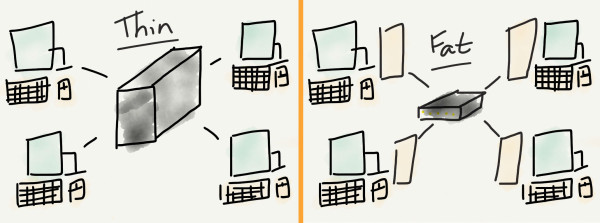The (alleged) 13-inch iPad and the triumph of thin clients
The (alleged) 13-inch iPad and the triumph of thin clients
The WSJ, in an article entitled Apple Tests Larger Screens for iPhones, iPads :
In recent months, Apple has asked for prototype smartphone screens larger than 4 inches and has also asked for screen designs for a new tablet device measuring slightly less than 13 inches diagonally, they said. The current iPhone 5 has a four-inch screen, while the iPad has a 9.7-inch screen. The iPad Mini, a stripped-down version of its tablet computer, has a 7.9-inch screen.
I can’t wait to buy one.
The idea of thin and fat clients has been around for years.

I like Wikipedia’s overview :
A thin client (sometimes also called a lean or slim client) is a computer or a computer program which depends heavily on some other computer (its server) to fulfill its computational roles. This is different from the traditional fat client, which is a computer designed to take on these roles by itself…
Thin clients occur as components of a broader computer infrastructure, where many clients share their computations with the same server. As such, thin client infrastructures can be viewed as providing some computing service via several user interfaces. This is desirable in contexts where individual fat clients have much more functionality or power than the infrastructure requires.
Thin-client computing is also a way of easily maintaining computational services at a reduced total cost of ownership.
While thin client architectures have gained some traction in certain line-of-business applications, the idea has never really taken hold broadly, and certainly not in the consumer market.
The reality of computing over the last 25 years has been a constant improvement in performance coupled with a constant decrease in price. Moreover, for the first two decades of the PC, there was a noticeable benefit for most users in that increased performance. The result was that the reduced performance of thin clients wasn’t justified by a minimal price advantage that was constantly disappearing. 1 And so, for the vast majority of uses and the vast majority of customers, fat clients ruled the day.
Or rather fat client, in the singular. For 25 years users typically relied on one general purpose fat client PC that was capable of accomplishing a wide range of tasks. The beneficiaries, of course, were Microsoft, who owned the dominant fat client operating system, and Intel, which provided the ever-improving performance.
That advantage is famously slipping away – or rather, falling off a cliff – in the face of tablets, (literally) thin devices with a new input method – touch – and new operating systems designed for different use cases and constraints.
The result is not a displacement of PCs, but rather an augmentation. The vast majority of people 2 who have tablets also have a PC, albeit one that they likely purchased a while ago. Performance finally ended up being good enough, and money was better spent on all the new uses unlocked by tablets.
The result has been a split in people’s computing – and tablets have taken the majority.

Still, the experiences aren’t entirely disparate; they’re still tied together by the cloud. Perhaps it’s as basic as email being in sync across devices (phones too, of course), or perhaps the user is more sophisticated and uses something like Dropbox. Regardless, their computing experience is not completed by just one device, and not everything that matters happens locally.
In a way, it’s a thin architecture.
To be clear, the classic definition of a thin architecture dictates that processing happens on the server, and that’s mostly not the case today. Tablets are very capable machines with full app libraries and modern browsers that run client-side code with aplomb. But that’s actually kind of the point: maybe the reason thin architectures never took off was that we had the definition – and associated advantages – all wrong.
While a classic thin architecture moves processing to the server, enabling cheaper clients, those clients still have a GUI, mouse and keyboard. In other words, the experience is largely the same as a fat client, minus the superior performance and responsiveness. Tablets, however, are orthogonal to PCs; they are inferior in some ways (performance, text entry), but superior in others (size, battery life, touch). They have a reason-to-own other than price.
Thinking about capabilities beyond processing casts Microsoft’s Windows 8 troubles in stark relief. Windows 8, with it’s mixture of touch and WIMP-interface is the ultimate fat client. But by combining so many capabilities, it necessarily compromises them as well.
Today’s thin clients, on the hand, specialize. A pure tablet is superior for touch-based applications; a pure PC is superior for keyboard-and-mouse ones. An e-ink reader is superior for reading, and a 13-inch iPad would be superior for (in my case) drawing and making music. And while many people now use two devices, I think that’s only the beginning (I’m personally at four and the 13″ iPad would be number five).

PCs are like Humpty Dumpty ; they are being broken into pieces and won’t be put back together again.
文章版权归原作者所有。
